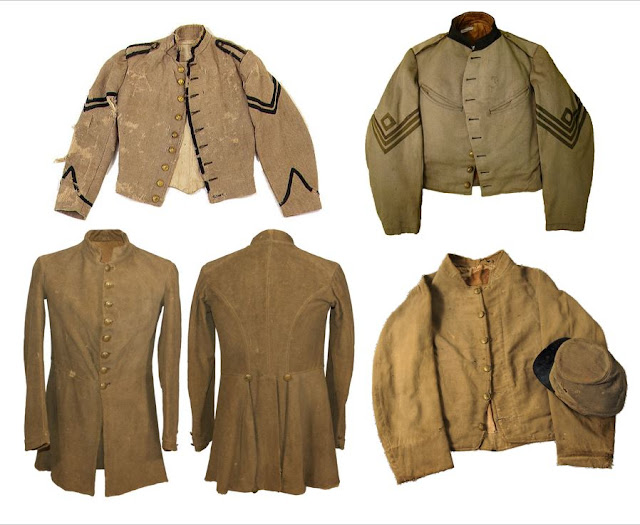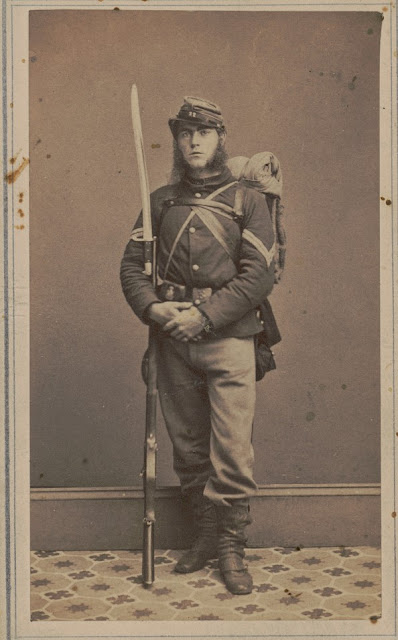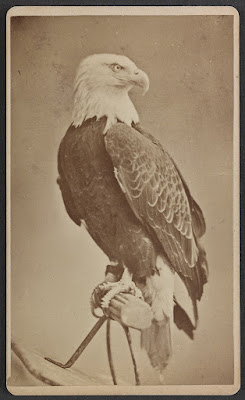Catching a Hatful of Bullets: With the 2nd Minnesota at Chickamauga
The 2nd Minnesota fought on four separate occasions during the two days of the Battle of Chickamauga. One soldier recalled that the hottest fighting occurred on the morning of September 20th when the regiment was trying to hold the left of the Union line.
“Here the Rebels came up on our left flank,” he noted. “We changed front to meet them with the 9th Ohio in advance and were immediately ordered to lie down. Here was the hottest place for bullets I ever saw. It seemed as though we could have held up our hats and caught a hatful. The 9th Ohio broke, but rallied in our rear and for a few minutes, the fighting was terrific, the Rebels hurling mass after mass to the front but in vain. Our Minies could go through four ranks at short range but they could not stand the slaughter and fled."
"The 9th Ohio and 87th Indiana charged across the field in front, the 35th Ohio passed on and we, according to orders, caught up the rear. At the edge of the woods in front we halted and were again ordered to lie down. Here we were in exact range of a Rebel battery but a few rods in advance in the road. They poured in grape and canister and here Ambrose Palmer was killed; he was struck in the side and scarcely moved except to slightly raise one hand which he dropped very quietly by his side," he wrote.
This following letter, written by an unknown soldier of Co. B of the 2nd Minnesota, first saw publication in the October 24, 1863, edition of the Rochester City Post.
Chattanooga,
Tennessee
October 5,
1863
Thinking a plain statement of the
history of Co. B of the 2nd Minnesota during the days of the 19th
and 20th of September 1863 might not be uninteresting to the friends
of those who shed their blood and laid down their lives on that trying
occasion, I will relate its principal incidents.
On the night of the 18th at
6 p.m., we were ordered to march left in front with 20 extra rounds of
cartridges. We marched all night and in the morning arrived in the vicinity of
the enemy who was endeavoring to cut off our communication with Chattanooga. We
had half an hour in which to make coffee then we marched off to the right of
the road, threw out skirmishers, formed our line of battle and advanced a mile
before halting in position. The skirmishing soon commenced on the right of the
division, rolling towards the extreme left, the position of the 2nd
Minnesota. The first attack was a light one, the regiment losing only two or
three wounded and was repulsed with ease.
For half an hour scarcely a gun was
fired when it suddenly opened in our front and rather to the left, apparently
nearing us rapidly. Suddenly, the woods in our front swarmed with a confused
mass of our men, running rapidly to the rear. Upon inquiry, we found it was the
Third Brigade, U.S. Regulars, belonging to Rousseau’s division. Our officers
called upon the men to stand, but they showed no disposition to move but lay
down quietly and cursed the Regulars as they retreated over them.
Hardly had the Regulars passed when
the Rebels came down. For 20 minutes the fighting was fierce; when the Rebels
gave back, the 9th Ohio charged and retook the 5th
Regular Battery which the Regular Brigade had lost. In this fight,
Co. B lost Samuel D. Calvert. A few minutes later and the Rebels appeared on
our left flank. We were ordered to change front by the left flank. The order
was given late and we executed it under a hot fire and lost the heaviest of the
day. But we soon opened on them and the 4th U.S. Battery, belonging
to our brigade, poured in a terrible fire.
The left of the regiment was ordered
to fall back 20 paces; they did so, relined themselves, and opened once more,
pouring in a left oblique fire with such effect that in a few minutes the
Rebels fell back and with us, the fighting for the day closed. We learned from
prisoners and deserters that we had been fighting Walker’s division of
Longstreet’s corps. That evening, we marched off to the right and rested as
best we could in the bitter cold.
Until 9 o’clock the next morning,
scarcely a shot was fired. We moved to the front, double column closed in mass
with our brigade in reserve. By and by there came an occasional shot from the
woods in front, gradually becoming sharper and quicker until the woods roared
with musketry, accompanied with the booming of cannons and the occasional
striking of projectiles rather nearer to our closed ranks than was agreeable to
your humble servant. But our men were pushing them, and we moved on into the
woods which we crossed and struck the open field beyond.
Here the Rebels came up on our left
flank; we changed front to meet them with the 9th Ohio in advance
and were immediately ordered to lie down. Here was the hottest place for
bullets I ever saw. It seemed as though we could have held up our hats and
caught a hatful. The 9th Ohio broke, but rallied in our rear and for
a few minutes, the fighting was terrific, the Rebels hurling mass after mass to
the front but in vain. Our Minies could go through four ranks at short range
but they could not stand the slaughter and fled. Here Ellis A. Comstock was
wounded.
The 9th Ohio and 87th
Indiana charged across the field in front, the 35th Ohio passed on and we, according to orders, caught up the rear. At the edge of the
woods in front we halted and were again ordered to lie down. Here we were in
exact range of a Rebel battery but a few rods in advance in the road. They
poured in grape and canister and here Ambrose H. Palmer was killed; he was
struck in the side and scarcely moved except to slightly raise one hand which
he dropped very quietly by his side.
The 35th Ohio drove them
from our front and we moved up about 20 rods and lay down once more. Here the
35th Ohio was driven back and we were quickly engaged in one of the
fiercest fights of the day. From this time, the discouraging part of the day
commenced. The regiment on the left (I did not get its name) gave way; the
Rebels began to flank us and we were ordered to fall back which was done by
passage of lines to the rear until we took up a new position about 4 o’clock
half a mile to the rear of Missionary Ridge.
The regiment on our left had formed a
rail breastwork and was prepared to hold it. The 9th Ohio formed on
our left and the 35th Ohio on the right. The Rebels soon advanced
and for two and a half hours it was hard telling how it would go; the Rebels
planted their colors within a rod of the breastworks on our left and were repeatedly
driven back. Cartridges became exhausted, the boxes of the dead were searched
and emptied and every available means resorted to for ammunition. It was almost
dark when the Rebels withdrew and left us in possession of the hill.
Half an hour later and we took up our
line of march for Rossville where we rested for the night and had time to count
the dead, the wounded, and the missing. We went into the fight with 37 men on
Saturday morning; we came out on Sunday evening leaving 5 of them dead on the
field, 13 wounded, and 2 taken prisoners. Since our return to Chattanooga, Hezekiah
G. Smith lost a finger by a shot from a sharpshooters while going on picket.
 |
| Second Minnesota monument which is located at Horseshoe Ridge at Chickamauga-Chattanooga National Battlefield. |
It is not for me to relate more than
the simple fact of what was done; what is true of Co. B is true of the
regiment. Every man did his duty and the memory of our dead shall by sacred
forever. We know they fought with unflinching determined bravery and while
their friends mourn them, let them be assured that this company mourns with
them for long association had made their vacant places in the ranks as sacred
as the vacant chair of the family hearthstone.
The regiment lost in the battle 153 killed and wounded. Every officer did his duty: Colonel [James] George was cool and steady, Lieutenant Colonel [Judson] Bishop was everywhere in the right place and in the right time, and Major [John B.] Davis has a look that would make a coward fight. Captain Abram Harkins, when he left the field with his arm left broken, told the boys to fight to the last. All our field officers had their horses shot under and all were slightly wounded, but not seriously. [Captain Harkins would lose his left arm to amputation and resigned his commission June 20, 1864.]
To learn more about the Battle of Chickamauga, please check out my Battle of Chickamauga page which features dozens of accounts from both Federal and Confederate combatants.
To learn more about the service of the 2nd Minnesota Infantry, please check out these posts:
Nip and Tuck with the 2nd Minnesota at Mill Springs
A Tale of Two Colonels: A Blue and Gray View of Mill Springs
A Librarian's First Battle: At Mill Springs with the 2nd Minnesota
A Fight for Corn: Eight Medals of Honor Awarded at Nolensville
Source:
Letter from
Soldier of Co. B, 2nd Minnesota Volunteer Infantry, Rochester
City Post (Minnesota), October 24, 1863, pg. 2












Comments
Post a Comment